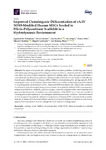Mostrar o rexistro simple do ítem
Improved Chondrogenic Differentiation of rAAV SOX9-Modified Human MSCs Seeded in Fibrin-Polyurethane Scaffolds in a Hydrodynamic Environment
| dc.contributor.author | Venkatesan, Jagadeesh Kumar | |
| dc.contributor.author | Rey-Rico, Ana | |
| dc.contributor.author | Cucchiarini, Magali | |
| dc.contributor.author | Madry, Henning | |
| dc.contributor.author | Gardner, Oliver | |
| dc.contributor.author | Eglin, David | |
| dc.contributor.author | Alini, Mauro | |
| dc.contributor.author | Stoddart, Martin J. | |
| dc.date.accessioned | 2024-07-10T17:21:52Z | |
| dc.date.available | 2024-07-10T17:21:52Z | |
| dc.date.issued | 2018 | |
| dc.identifier.citation | Venkatesan, J.K.; Gardner, O.; Rey-Rico, A.; Eglin, D.; Alini, M.; Stoddart, M.J.; Cucchiarini, M.; Madry, H. Improved Chondrogenic Differentiation of rAAV SOX9-Modified Human MSCs Seeded in Fibrin-Polyurethane Scaffolds in a Hydrodynamic Environment. Int. J. Mol. Sci. 2018, 19, 2635. https://doi.org/10.3390/ijms19092635 | es_ES |
| dc.identifier.uri | http://hdl.handle.net/2183/37902 | |
| dc.description.abstract | [Abstract] The repair of focal articular cartilage defects remains a problem. Combining gene therapy with tissue engineering approaches using bone marrow-derived mesenchymal stem cells (MSCs) may allow the development of improved options for cartilage repair. Here, we examined whether a three-dimensional fibrin-polyurethane scaffold provides a favorable environment for the effective chondrogenic differentiation of human MSCs (hMSCs) overexpressing the cartilage-specific SOX9 transcription factor via recombinant adeno-associated virus (rAAV) -mediated gene transfer cultured in a hydrodynamic environment in vitro. Sustained SOX9 expression was noted in the constructs for at least 21 days, the longest time point evaluated. Such spatially defined SOX9 overexpression enhanced proliferative, metabolic, and chondrogenic activities compared with control (reporter lacZ gene transfer) treatment. Of further note, administration of the SOX9 vector was also capable of delaying premature hypertrophic and osteogenic differentiation in the constructs. This enhancement of chondrogenesis by spatially defined overexpression of human SOX9 demonstrate the potential benefits of using rAAV-modified hMSCs seeded in fibrin-polyurethane scaffolds as a promising approach for implantation in focal cartilage lesions to improve cartilage repair. | es_ES |
| dc.description.sponsorship | This research was funded by a grant from the Collaborative Research Partner Acute Cartilage Injury Program of AO Foundation, Davos, Switzerland (Henning Madry, Magali Cucchiarini, David Eglin, Mauro Alini, Martin J. Stoddart. We thank R.J. Samulski (The Gene Therapy Center, University of North Carolina, Chapel Hill, NC, USA), X. Xiao (The Gene Therapy Center, University of Pittsburgh, Pittsburgh, PA), and E.F. Terwilliger (Division of Experimental Medicine, Harvard Institutes of Medicine and Beth Israel Deaconess Medical Center, Boston, MA) for providing the genomic AAV-2 plasmid clones and the 293 cell line, and G. Scherer (Institute for Human Genetics and Anthropology, Albert-Ludwig University, Freiburg, Germany) for the human SOX) sequence | es_ES |
| dc.language.iso | eng | es_ES |
| dc.publisher | MDPI | es_ES |
| dc.relation.uri | https://doi.org/10.3390/ijms19092635 | es_ES |
| dc.rights | Creative Commons Attribution(CC BY) license 4.0 | es_ES |
| dc.rights.uri | http://creativecommons.org/licenses/by/3.0/es/ | * |
| dc.subject | Cartilage repair | es_ES |
| dc.subject | HMSCs | es_ES |
| dc.subject | Chondrogenesis | es_ES |
| dc.subject | RAAV | es_ES |
| dc.subject | SOX9 | es_ES |
| dc.subject | Fibrin-polyurethane scaffolds | es_ES |
| dc.subject | Bioreactors | es_ES |
| dc.title | Improved Chondrogenic Differentiation of rAAV SOX9-Modified Human MSCs Seeded in Fibrin-Polyurethane Scaffolds in a Hydrodynamic Environment | es_ES |
| dc.type | info:eu-repo/semantics/article | es_ES |
| dc.rights.access | info:eu-repo/semantics/openAccess | es_ES |
| UDC.journalTitle | International Journal of Molecular Sciences | es_ES |
| UDC.volume | 19 | es_ES |
| UDC.issue | 9 | es_ES |
| UDC.startPage | 2635 | es_ES |
| dc.identifier.doi | 10.3390/ijms19092635 |






